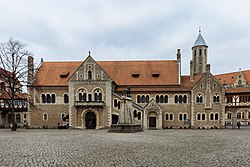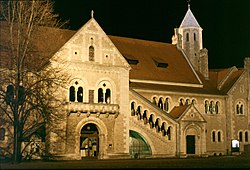
Braunschweig or Brunswick is a city in Lower Saxony, Germany, north of the Harz Mountains at the farthest navigable point of the river Oker, which connects it to the North Sea via the rivers Aller and Weser. In 2016, it had a population of 250,704.

Wolfenbüttel is a town in Lower Saxony, Germany, the administrative capital of Wolfenbüttel District. It is best known as the location of the internationally renowned Herzog August Library and for having the largest concentration of timber-framed buildings in Germany, around 1000. It is an episcopal see of the Evangelical Lutheran Church in Brunswick. It is also home to the Jägermeister distillery, houses a campus of the Ostfalia University of Applied Sciences, and the Landesmusikakademie of Lower Saxony.

The Duchy of Brunswick was a historical German state. Its capital was the city of Brunswick . It was established as the successor state of the Principality of Brunswick-Wolfenbüttel by the Congress of Vienna in 1815. In the course of the 19th-century history of Germany, the duchy was part of the German Confederation, the North German Confederation and from 1871 the German Empire. It was disestablished after the end of World War I, its territory incorporated into the Weimar Republic as the Free State of Brunswick.

Augustus II, called the Younger, a member of the House of Welf was Duke of Brunswick-Lüneburg. In the estate division of the House of Welf of 1635, he received the Principality of Wolfenbüttel which he ruled until his death. Considered one of the most literate princes of his time, he is known for founding the Herzog August Library at his Wolfenbüttel residence, then the largest collection of books and manuscripts north of the Alps.

The Herzog Anton Ulrich Museum (HAUM) is an art museum in the German city of Braunschweig, Lower Saxony.
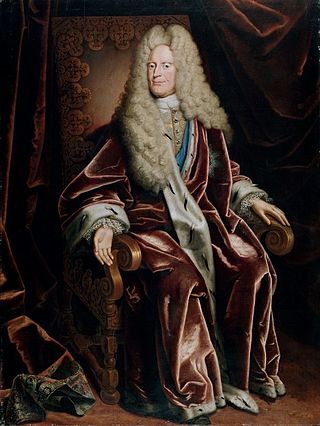
Anthony Ulrich, a member of the House of Welf, was Duke of Brunswick-Lüneburg and ruling Prince of Brunswick-Wolfenbüttel from 1685 until 1702 jointly with his elder brother Rudolph Augustus, and solely from 1704 until his death. He was one of the main proponents of enlightened absolutism among the Brunswick dukes.

The Free State of Brunswick was a state of the German Reich in the time of the Weimar Republic. It was formed after the abolition of the Duchy of Brunswick in the course of the German Revolution of 1918–19. Its capital was Braunschweig (Brunswick). In 1933 it was de facto abolished by Nazi Germany. The free state was disestablished after the Second World War in 1946.

Langeleben is a historical location at 260 m above sea level, in the northern part of the Elm ridge in Lower Saxony, Germany and today belongs to the nearby town of Königslutter am Elm. Langeleben was a crossing point for three ancient roads through the Elm district. In the past a respectable stately home, a moated castle built in the Middle Ages, stood here, as did a hunting lodge and hamlet which were also called Langeleben. This once important estate and village was home to an average of 80 residents who were responsible for the clearing and management of a large area of the then dense forest. A lightly wooded area for a cemetery contain many old graves under the trees. From the original castle only some remnants of the foundations can today be seen. No trace can be found of the village or former hunting lodge which once belonged to the Duke of Brunswick in the 18th century.

Brunswick Land is a historical region in the Southeast of the German state of Lower Saxony, centred around the city of Braunschweig. It refers to the core territory of the historic Duchy of Brunswick and its successor, the Free State of Brunswick, which was disestablished in 1946.

The Brunswick Lion is a medieval sculpture, created in bronze between 1164 and 1176, and the best-known landmark in the German city of Brunswick. The Brunswick Lion was originally located on the Burgplatz square in front of the Brunswick Cathedral. The monument was moved to Dankwarderode Castle in 1980, and later replaced at the original location by a replica. Within Brunswick, it is commonly known as the "Castle Lion" (Burglöwe).
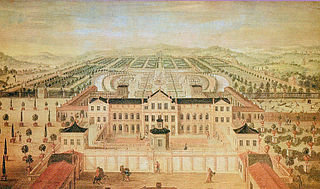
Schloss Salzdahlum was a former summer palace built by Anthony Ulrich, Duke of Brunswick-Wolfenbüttel in 1684. For cost reasons, the buildings were almost exclusively made of wood, with the cladding giving the impression of a building made of sandstone. In 1813 the castle was demolished due to dilapidation; today there are almost no remains of the building.
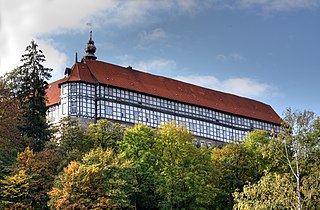
Herzberg Castle is a German schloss in Herzberg am Harz in the district of Göttingen in the state of Lower Saxony. The present-day, quadrangular building has its origins in the 11th century as a medieval castle. After a fire in 1510 it was rebuilt as a schloss and is one of the few in Lower Saxony that was constructed as a timber-framed building. Because it belonged to the House of Welf for 700 years it is also known as the Welf Castle of Herzberg.
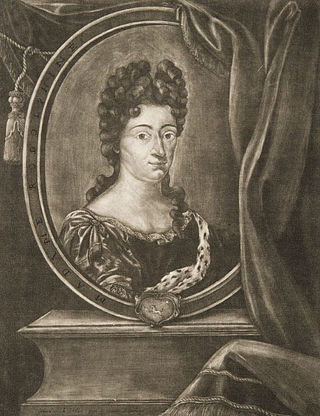
Rosine Elisabeth Menthe, was married morganatically with Duke Rudolph Augustus of Brunswick-Wolfenbüttel (1627–1704), Duke of Brunswick-Lüneburg and Prince of Brunswick-Wolfenbüttel.

The Innenstadt is the central Stadtbezirk (borough) of Braunschweig, Germany. The district consists of five formerly independent city municipal areas, and is surrounded by the river Oker and in area nearly identical to the medieval city of Braunschweig.

Hermann Korb was a German architect who worked mainly in the Principality of Brunswick-Wolfenbüttel.

The following is a timeline of the history of the city of Braunschweig (Brunswick), Germany.

The Akademie Rudolph-Antoniana was an early modern Ritterakademie sited in Wolfenbüttel in what was then the Duchy of Brunswick-Lüneburg in Germany. It was founded on 18 July 1687 by Rudolph Augustus and Anthony Ulrich, brothers and co-dukes of the Duchy. It was housed in the Kleines Schloss in Wolfenbüttel, right next to the Schloss Wolfenbüttel and its Herzog August Library, meaning students could borrow books from there but also get to know court-life, such as operas, plays and hunting in the Harz and Elm.

Schloss Wolfenbüttel is a castle in Wolfenbüttel, Lower Saxony, Germany. An extensive four-wing complex, it originated as a moated castle (Wasserburg). It is the second-largest surviving schloss in Lower Saxony and served as the main residence of the rulers of the Principality of Brunswick-Wolfenbüttel from 1432 to 1753. It now houses a gymnasium secondary school, the Federal Academy of Arts Education, and a museum with its historic rooms on display. Its immediate vicinity is home to several historically significant buildings including the Herzog August Bibliothek, the Lessinghaus, the Zeughaus, and the Kleines Schloss.
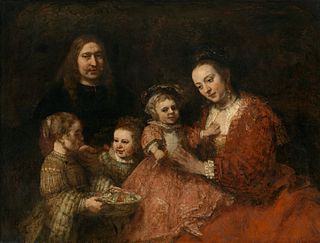
Portrait of a Family or the Brunswick Family Portrait is a 1668 oil on canvas painting by Rembrandt, now in the Herzog Anton Ulrich-Museum in Braunschweig. Its subjects are unidentified.
Gertrude the Elder of Brunswick, also known as Gertrude of Egisheim, donated together with her husband Liudolf of Brunswick the collegiate church of St. Blasius in Braunschweig and founded the later so-called Welfenschatz.
